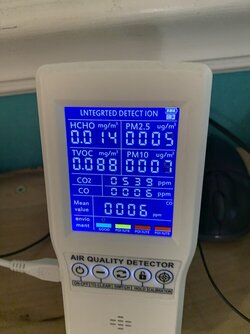Air quality is indeed a subject I have learned more about than I set out to learn.
4 year old daughter with congestion might be Air Quality, could be hanging out with enough other 4 year olds that there is a constant turn over in garden variety URIs, as above cold be allergies. Can be chemicals in products, the wife and got the last of our wall to wall carpet out this summer.
Divide and conquer I say.
One thing can (should be able to) do is find a local fancy-schmancy air quality monitoring station. I dunno how thick on the ground beta attenuation monitors are back east, a decent BAM unit to count particles will set somebody back $30k, but if there is one near you book mark it in your browser and keep an eye on it. What are the local (outdoor ambient) particle counts when your daughter is having a bad day?
I say this because of your population density. You got a lot of people in a pretty small area in pretty much all of NJ. If Manhattan had the same population density as Alaska there would be three people living in a log cabin at Battery Park (Anchorage) 1 person in a tent in Central Park (Fairbanks) and 2 others folks wandering around the rest of the island going to where ever the fish are running or the game is grazing. I am not sure how many orders of magnitude that is, but you got a lot of people near you burping and passing gas and running their BBQ grills and driving their cars. I am confident you got some particles to count in your outdoor ambient air.
Second is indoor ambient.
You might as well go read up on this thread:
https://www.hearth.com/talk/threads/homemade-air-filters-good-indoor-air-quality-cheap.188986/
and then come back here so I can comment on what I already said without having to type the whole thing twice.
At this point I have two battles.
One is particles generated inside my house, from the geriatric cat, the wood stove, the now absent wall to wall carpet. For those, assuming good/excellent outdoor air quality, I run a single 20" box fan with a single MERV 13 (20x20) furnace filter duct taped neatly to the intake side of the box fan. I replace that filter about every six months. I used a IR thermometer to check the motor housing temperature on the box fan daily for about I dunno, my eyes were bleeding, maybe four months or so. The fan motor was constantly either the same temp as ambient air, or +1dF. I just couldn't monitor it any more after a few months. There are a few days in spring pollen season where we close the windows to let the single filter/ single fan keep the pollen inside the house knocked back, and then reopen the windows once the pollen is done.
Outdoor particles is my other battle. BRB. My nearest BAM counter is the one labelled "NCore"
https://dec.alaska.gov/air/air-monitoring/alaska-air-quality-real-time-data . Right this moment the controlling variable for air quality is ( no surprise) PM2.5 wiht a measurement of 8 micrograms per cubic meter which converts to a useless AQ "Index" that means my air quality is "good". I dunno how many bureacrats went to how many meetings to come up with the dang air quality "index" but I want my tax dollars returned with interest. The index my opinion, is a stupid pointless useless distraction from good science and useful data. Micrograms per cubic meter is good science. Indexes are for people who wager on the stock market or hire dowsers to locate well water.
So anyway, outdoor particles. In the last 12 months my outdoor ambient PM2.5 count (in mcg/m3) has varied from 0-477. With outdoor counts from 0-125 mcg/m3 my single filter/ single fan array, fan speed set to low, can keep my indoor PM2.5 counts in the 0-6 range.
I'll get around to the V portion of HVAC systems next, at my house all I have for V is a courtesy fan in each of the two bathrooms, and when it is running my woodstove takes combustion air from the living space. In summertime wild fire season where the particle counts get really out of hand I can count on the EPA to be running radio ads about how important wintertime air quality is while not giving any EPA $ to hire smoke jumpers and I want the money spent on summertime radio advertisements refunded to me as well. Sorry, sore subject here. When the outdoor particle counts exceed 125 mcg/m3 I got to dust off some more sophisticated filtration to keep my indoor air quality good. I have a couple cubes that can take 3 20x20 furnace filters (MERV 13 if you recall) and a monster cabinet that holds six 20x20 filters with a 20 inch fan on that one too. When the air gets bad enough (~300 mcg/m3 and up) I will have all of those running full blast to keep my home in the "moderate" or "unhealthy for sensitive groups" ranges.
K. So the problem with ventilation ductwork it is hard to clean poorly and likely impossible to clean well at the residential scale. I have seen commercial scale air handlers with a man door, where you can walk in there with a dust rag and get busy; but the final duct work on those, for individual rooms, not cleanable. If you got crap in your ductwork my advice is to sell your house. Go buy some place with steam radiators and opable windows.
I shall now approach the electric third rail, VOCs, with a well insulated battle axe. If you want to measure VOCs accurately you are screwed. There is a field effect transistor that actually changes its field behavior in the presence of carbon dioxide. If you have a good sized conference room, this is handy. Empty room, the HVAC system just keeps up with temperature. If 200 people show up in the next ten minutes to hear your inspirational sales speech they will be blowing off CO2, a sophisticated HVAC system can detect the CO2 and start the ventilation fans so folks don't pass out from lack of oxygen while you are banging on about fourth quarter sales goals.
If you want to know if the CO2 in your conference room is 16 or 17 parts per million, this semiconductor simply cannot provide that kind of resolution. You may have heard of MOSFETS. Metal Oxide Something Field Effect Transistor. Great idea. Less material. Lower cost. Instead of physical P-N junctions inside the transistor, the FET family generates fields in the air near the semiconductor that interact. IIRC MOSFETs started showing up in consumer amplifier circuits in the mid to late 1990s. I don't recall which are the P and N dopes in the xyzFET that changes its characteristics in the presence of CO2, or rather diminished partial pressure of oxygen because of (most of the time) increased CO2.
The bad news is some ahem, person, somewhere came up with some math to use this property to estimate VOC like formaldehyde. If you are looking at a consumer grade AQ monitor that is supposed to monitor VOCs and it costs less than $1000, someone is selling you an xyzFET and some software. When you get it home, spoof it with a gentle kiss from a CO2 fire extinguisher and see if it doesn't detect fatal levels of formaldehyde in your home. You're welcome.
To find out (in a definitive way) whether or not VOCs are a problem in your home, you have two options. One is to send away for an air flask. Follow the directions with the package, send the flask back to the supplier. They will run your air sample through a gas chromatograph machine. You get a report telling you what they found. The higher resolution you want, the more money you pay. The other option is to rent a handheld VOC detector from a local company that most likely has the words "fire and safety" in the business name. Garden State Fire and Safety. New Jersey Fire and Safety. I made these up. Keystone Fire and Safety. Something like that. One of those will have some handheld meters for rent. Retail value/ credit card deposit in the $3-5k range. Half or full day rentals local to me, with a discount for a week long rental. With one of these you can wander around your house looking to see if you have problem areas, without the accuracy of gas chromatography.



